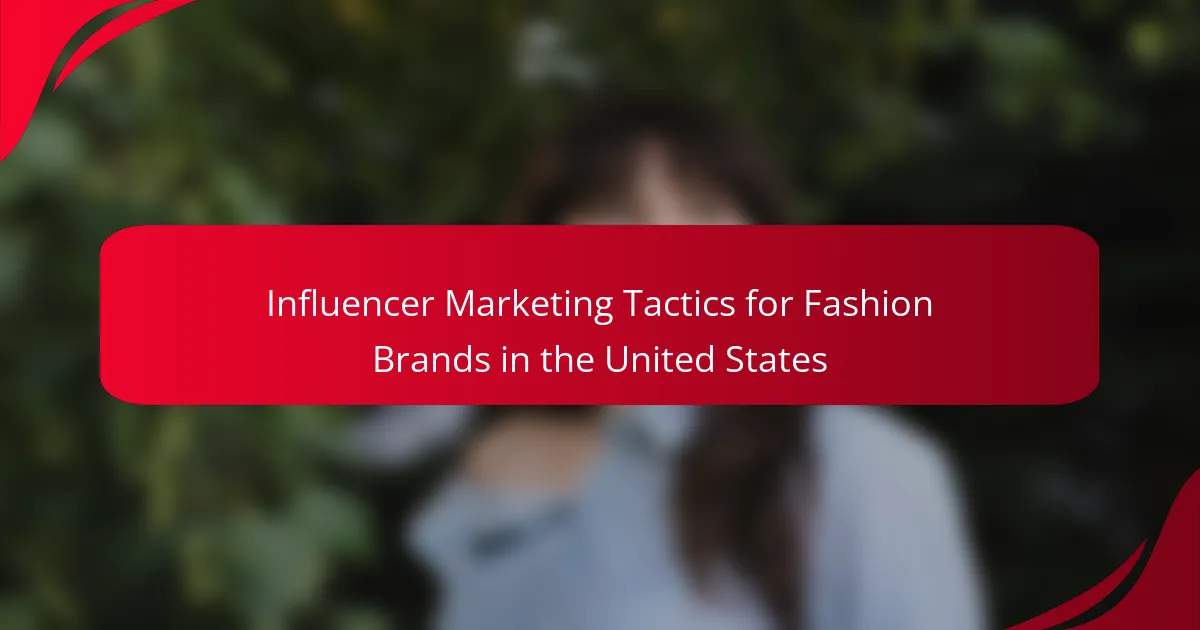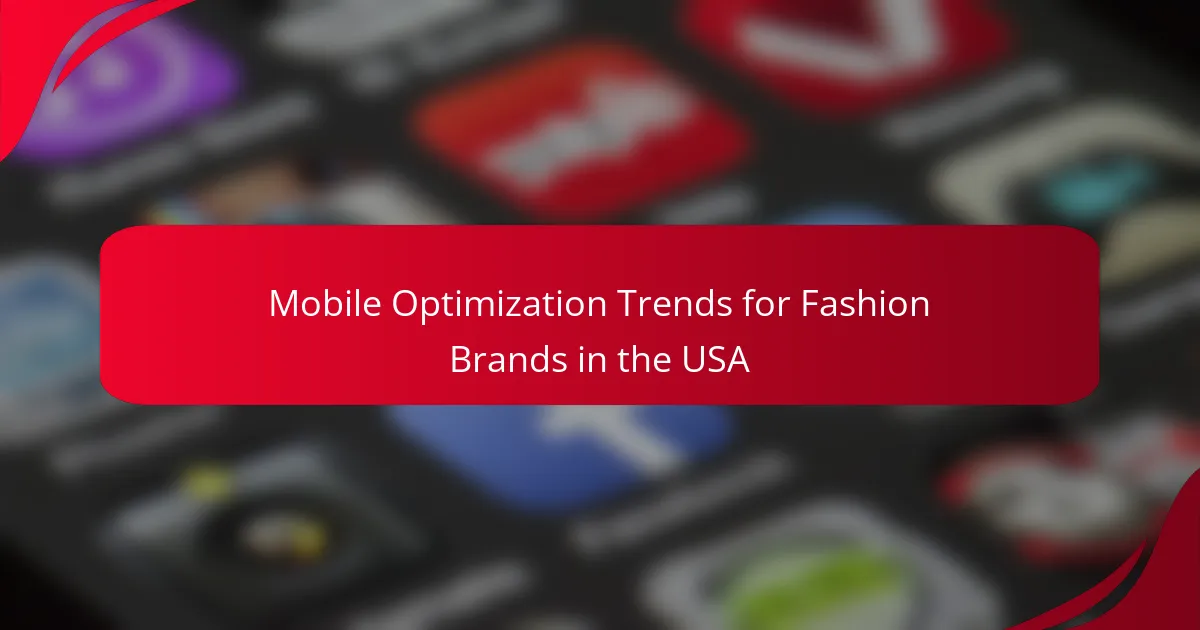Influencer marketing has become a vital strategy for fashion brands in the United States, enabling them to effectively connect with their target audiences. By leveraging tactics such as micro-influencers, social media takeovers, and brand ambassador partnerships, these brands can enhance visibility and drive sales. Choosing the right influencers based on audience alignment and engagement is crucial for maximizing campaign effectiveness across platforms like Instagram, TikTok, and YouTube.
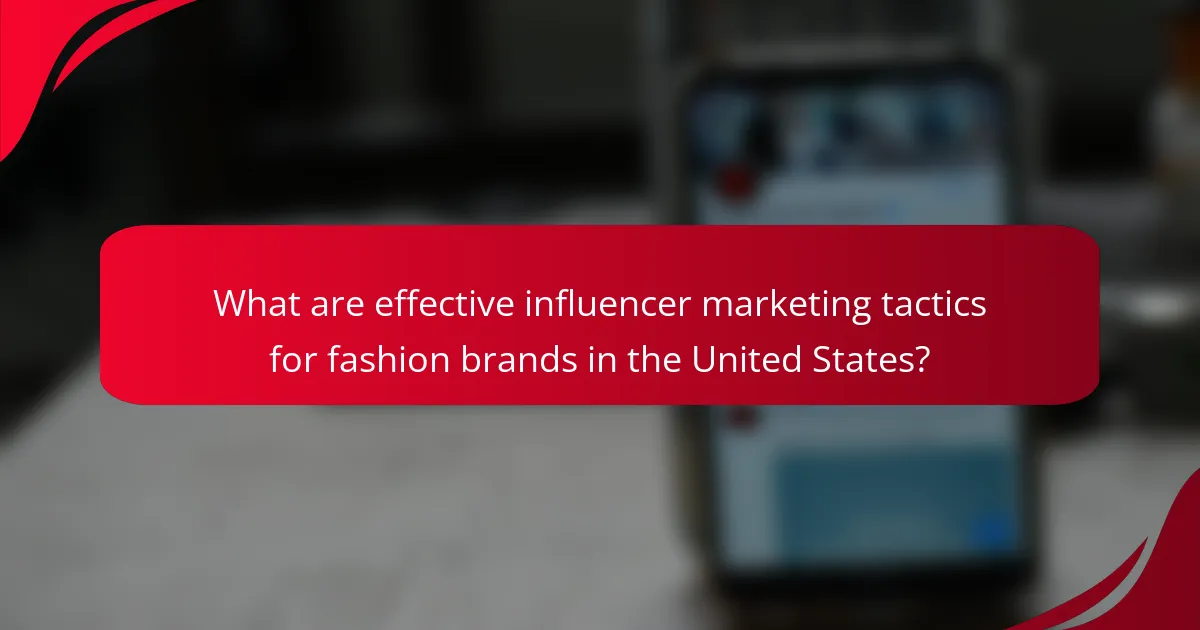
What are effective influencer marketing tactics for fashion brands in the United States?
Effective influencer marketing tactics for fashion brands in the United States include leveraging micro-influencers, engaging in social media takeovers, implementing affiliate marketing programs, establishing brand ambassador partnerships, and co-creating content. These strategies help brands connect with their target audience, enhance brand visibility, and drive sales.
Micro-influencer collaborations
Micro-influencer collaborations involve partnering with influencers who have a smaller but highly engaged following, typically ranging from 1,000 to 100,000 followers. These influencers often have a more personal connection with their audience, leading to higher engagement rates and trust. Fashion brands can benefit from these collaborations by creating authentic content that resonates with niche markets.
To maximize the impact of micro-influencer partnerships, brands should focus on aligning with influencers whose values and aesthetics match their own. Offering free products or exclusive discounts can incentivize influencers to promote the brand effectively.
Social media takeovers
Social media takeovers allow influencers to temporarily manage a brand’s social media account, providing a fresh perspective and engaging content. This tactic can generate excitement and attract new followers by showcasing the influencer’s unique style and approach to the brand’s products. Brands should consider scheduling takeovers during key events or product launches for maximum impact.
To ensure a successful takeover, brands should provide influencers with guidelines while allowing creative freedom. Monitoring engagement and feedback during the takeover can help assess its effectiveness and inform future collaborations.
Affiliate marketing programs
Affiliate marketing programs enable influencers to earn commissions on sales generated through their unique referral links. This performance-based approach motivates influencers to promote products more vigorously, as their earnings directly correlate with their efforts. Fashion brands can set competitive commission rates to attract influencers while ensuring profitability.
Brands should track affiliate performance using analytics tools to understand which influencers drive the most sales. Regular communication with affiliates can help refine strategies and enhance collaboration, leading to better results over time.
Brand ambassador partnerships
Brand ambassador partnerships involve long-term relationships with influencers who consistently represent the brand. These ambassadors often embody the brand’s values and aesthetics, creating a strong, authentic connection with their audience. Fashion brands can benefit from this tactic by fostering loyalty and trust over time.
To establish effective brand ambassador partnerships, brands should select influencers who genuinely love their products. Providing ambassadors with exclusive access to new collections or events can enhance their commitment and enthusiasm for promoting the brand.
Content co-creation
Content co-creation involves collaborating with influencers to produce original content that showcases the brand’s products. This approach not only leverages the influencer’s creativity but also ensures that the content feels authentic and relatable to their audience. Fashion brands can engage influencers in various formats, such as videos, blog posts, or social media campaigns.
Brands should encourage influencers to share their personal experiences with the products, as this can lead to more engaging and persuasive content. Setting clear objectives and guidelines while allowing for creative freedom can help achieve the desired outcomes from these collaborations.
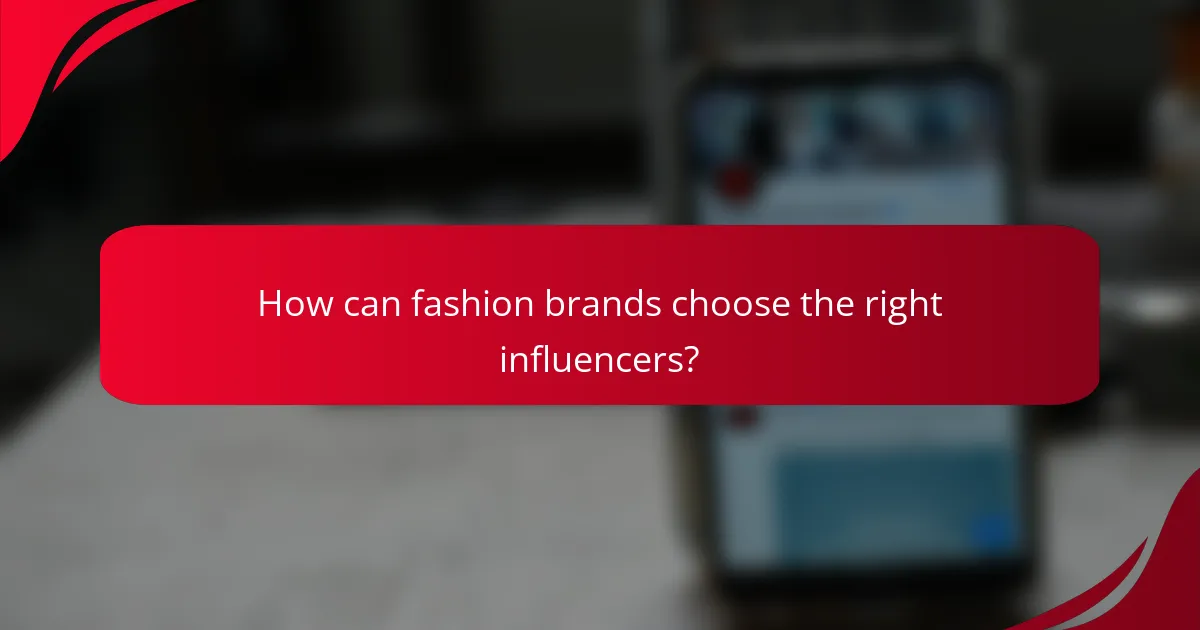
How can fashion brands choose the right influencers?
Fashion brands can choose the right influencers by focusing on key factors such as audience alignment, engagement rates, and compatibility with brand values. These elements ensure that the influencer’s reach and message resonate with the brand’s target market, maximizing the effectiveness of marketing campaigns.
Audience alignment
Audience alignment is crucial for fashion brands when selecting influencers. Brands should analyze the demographics, interests, and behaviors of an influencer’s followers to ensure they match the brand’s target audience. For instance, a luxury fashion brand may benefit from collaborating with influencers whose followers are primarily affluent individuals interested in high-end fashion.
To assess audience alignment, brands can use tools that provide insights into follower demographics and engagement patterns. This helps in determining whether the influencer can effectively reach potential customers.
Engagement rates
Engagement rates are a vital metric for evaluating an influencer’s effectiveness. High engagement rates indicate that followers are actively interacting with the influencer’s content, which can lead to increased brand visibility and sales. Brands should look for influencers with engagement rates typically ranging from 1% to 5%, depending on the platform and niche.
When assessing engagement, brands should consider not just likes, but also comments and shares, as these interactions demonstrate a deeper connection with the audience. Influencers with genuine engagement are more likely to drive meaningful conversations about the brand.
Brand values compatibility
Compatibility with brand values is essential for a successful influencer partnership. Fashion brands should seek influencers whose personal beliefs and messaging align with the brand’s mission and values. For example, a sustainable fashion brand would benefit from collaborating with influencers who advocate for eco-friendly practices.
To ensure compatibility, brands can review an influencer’s past content, partnerships, and public statements. This helps to avoid potential backlash and ensures that the collaboration feels authentic to both the influencer’s audience and the brand’s customers.
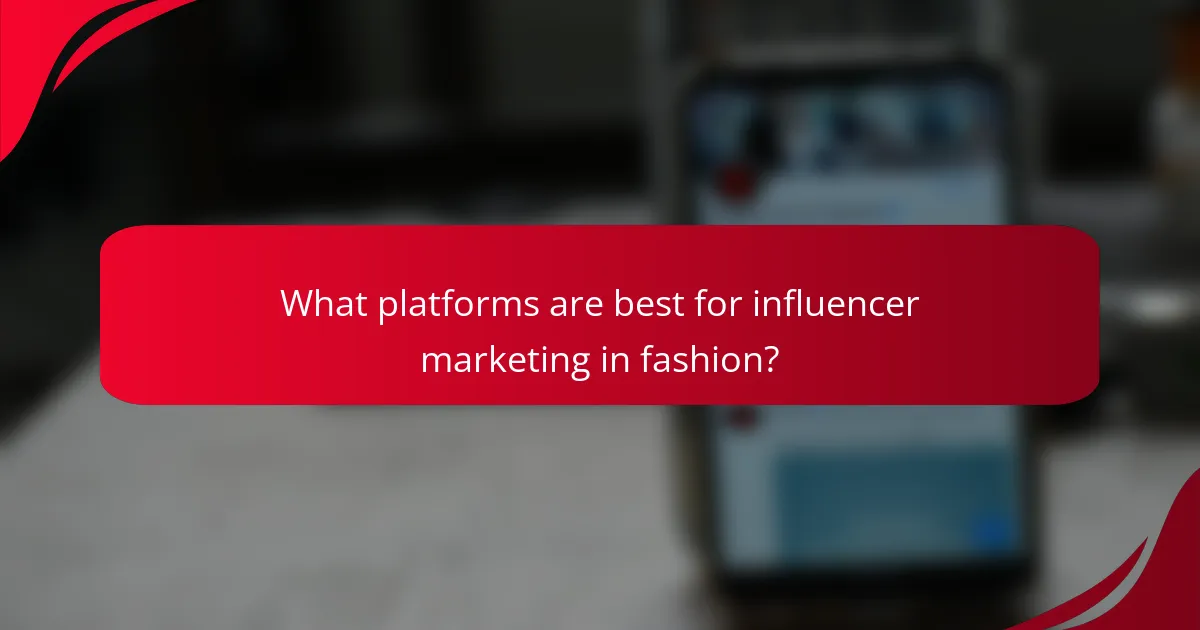
What platforms are best for influencer marketing in fashion?
The best platforms for influencer marketing in fashion include Instagram, TikTok, YouTube, and Pinterest. Each platform offers unique features that can enhance brand visibility and engagement with target audiences.
Instagram is a leading platform for fashion influencer marketing due to its visual nature and large user base. Brands can leverage high-quality images, Stories, and Reels to showcase products and create engaging content.
When collaborating with influencers, consider their follower demographics and engagement rates to ensure alignment with your target audience. Micro-influencers often yield higher engagement rates compared to larger accounts, making them a valuable choice for brands.
TikTok
TikTok has rapidly gained popularity for fashion marketing, especially among younger audiences. The platform’s short-form video format allows brands to create entertaining and authentic content that resonates with viewers.
Utilizing trending challenges and hashtags can amplify brand reach. Brands should focus on creativity and authenticity, as TikTok users prefer genuine content over polished advertisements.
YouTube
YouTube is ideal for in-depth fashion content, such as hauls, tutorials, and reviews. Influencers can create longer videos that provide detailed insights into products, helping to build trust with viewers.
Brands should consider partnerships with YouTubers who have a strong following in the fashion niche. Sponsored content should feel organic and informative, allowing for a seamless integration of products into the influencer’s existing content.
Pinterest serves as a powerful visual discovery platform for fashion brands, where users seek inspiration and ideas. Brands can create visually appealing pins that link back to their websites or product pages, driving traffic and potential sales.
Focus on creating high-quality images and infographics that showcase products in lifestyle contexts. Regularly updating boards and utilizing keywords can enhance visibility and engagement on the platform.
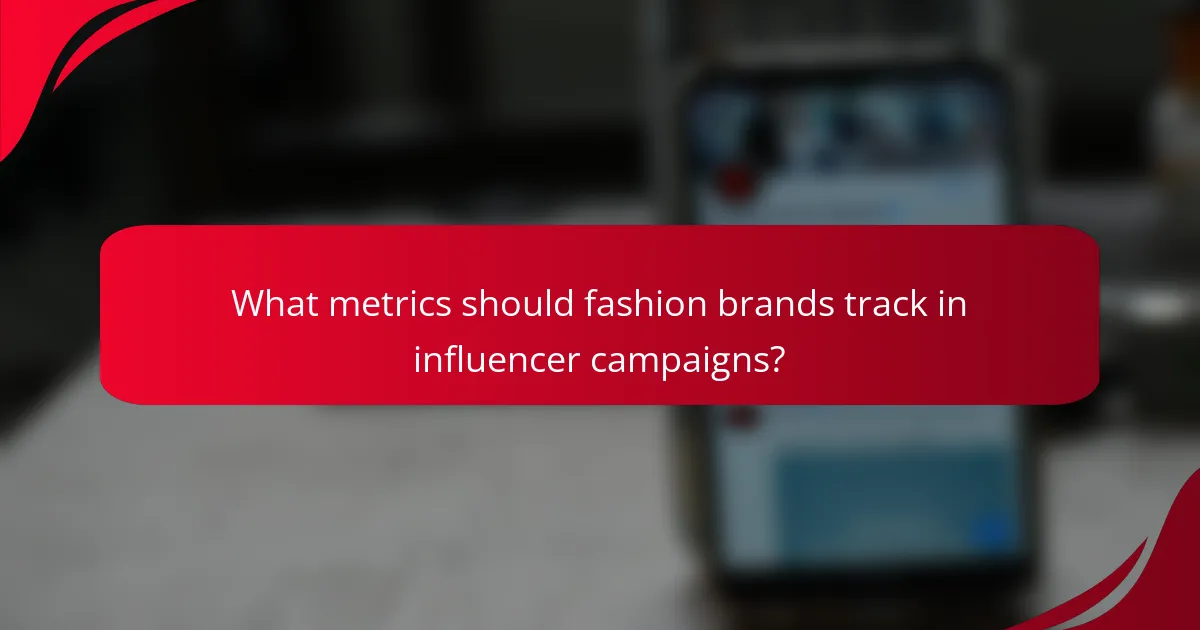
What metrics should fashion brands track in influencer campaigns?
Fashion brands should track metrics such as return on investment (ROI), engagement metrics, and brand awareness growth to evaluate the effectiveness of their influencer campaigns. These metrics provide insights into financial performance, audience interaction, and overall brand visibility.
Return on investment (ROI)
ROI measures the profitability of an influencer campaign by comparing the revenue generated against the costs incurred. To calculate ROI, use the formula: (Revenue – Cost) / Cost x 100. A positive ROI indicates that the campaign is financially beneficial.
Fashion brands should aim for a ROI of at least 5:1, meaning for every dollar spent, five dollars should be generated in revenue. Tracking sales conversions directly linked to influencer promotions can help assess this metric accurately.
Engagement metrics
Engagement metrics, such as likes, comments, shares, and saves, indicate how well the audience interacts with influencer content. High engagement rates suggest that the content resonates with the target demographic, which is crucial for fashion brands aiming to build a loyal customer base.
Brands should monitor engagement rates relative to the influencer’s follower count to identify effective partnerships. A good benchmark is an engagement rate of 1-3% for larger influencers and 3-10% for micro-influencers, as smaller audiences often yield higher interaction levels.
Brand awareness growth
Brand awareness growth measures how well consumers recognize and recall a brand after an influencer campaign. This can be assessed through surveys, social media mentions, and website traffic analytics. Increased brand visibility can lead to higher sales and customer loyalty over time.
Fashion brands can track brand awareness by analyzing metrics like reach and impressions on social media platforms. A successful campaign should aim for a noticeable increase in these metrics, ideally targeting a growth rate of 20-30% in brand mentions within a few months following the campaign launch.
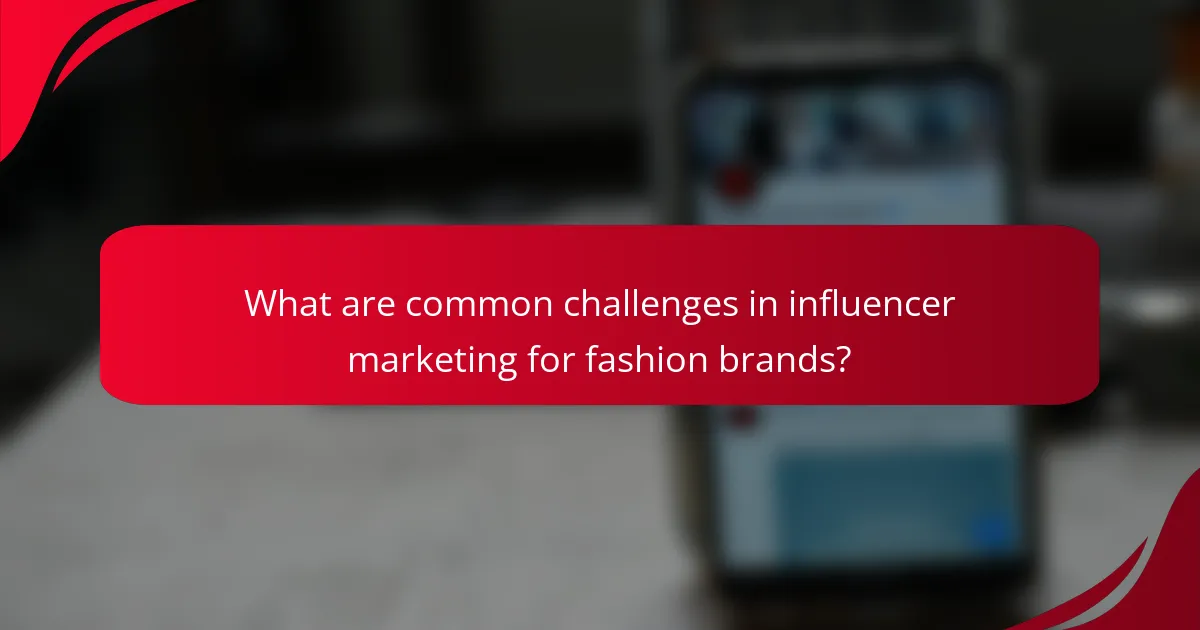
What are common challenges in influencer marketing for fashion brands?
Fashion brands often face several challenges in influencer marketing, including authenticity issues, compliance with regulations, and measuring campaign effectiveness. Addressing these challenges is crucial for maximizing the return on investment and ensuring brand integrity.
Authenticity issues
Authenticity is vital for influencer marketing, as consumers increasingly seek genuine connections with brands. If influencers promote products that don’t align with their personal style or values, it can lead to distrust among their followers. Brands should choose influencers whose aesthetics and beliefs resonate with their target audience.
To enhance authenticity, brands can collaborate with micro-influencers who have a more engaged and loyal following. These influencers often have a closer relationship with their audience, making their endorsements feel more credible.
Compliance with regulations
Fashion brands must navigate various regulations when working with influencers, particularly regarding disclosure requirements. In the United States, the Federal Trade Commission (FTC) mandates that influencers clearly disclose paid partnerships or sponsorships to maintain transparency with their audience.
Brands should provide clear guidelines to influencers on how to comply with these regulations. This includes using hashtags like #ad or #sponsored in posts, ensuring that disclosures are easily visible, and educating influencers about the importance of honesty in their promotions.
Measuring campaign effectiveness
Measuring the effectiveness of influencer marketing campaigns can be challenging for fashion brands. Key performance indicators (KPIs) such as engagement rates, reach, and conversion rates should be established before launching a campaign to assess its success accurately.
Brands can utilize tracking tools and analytics platforms to monitor these metrics. Setting up unique discount codes or affiliate links for influencers can also help in tracking sales directly attributed to their promotions. Regularly reviewing these metrics allows brands to refine their strategies for future campaigns.






